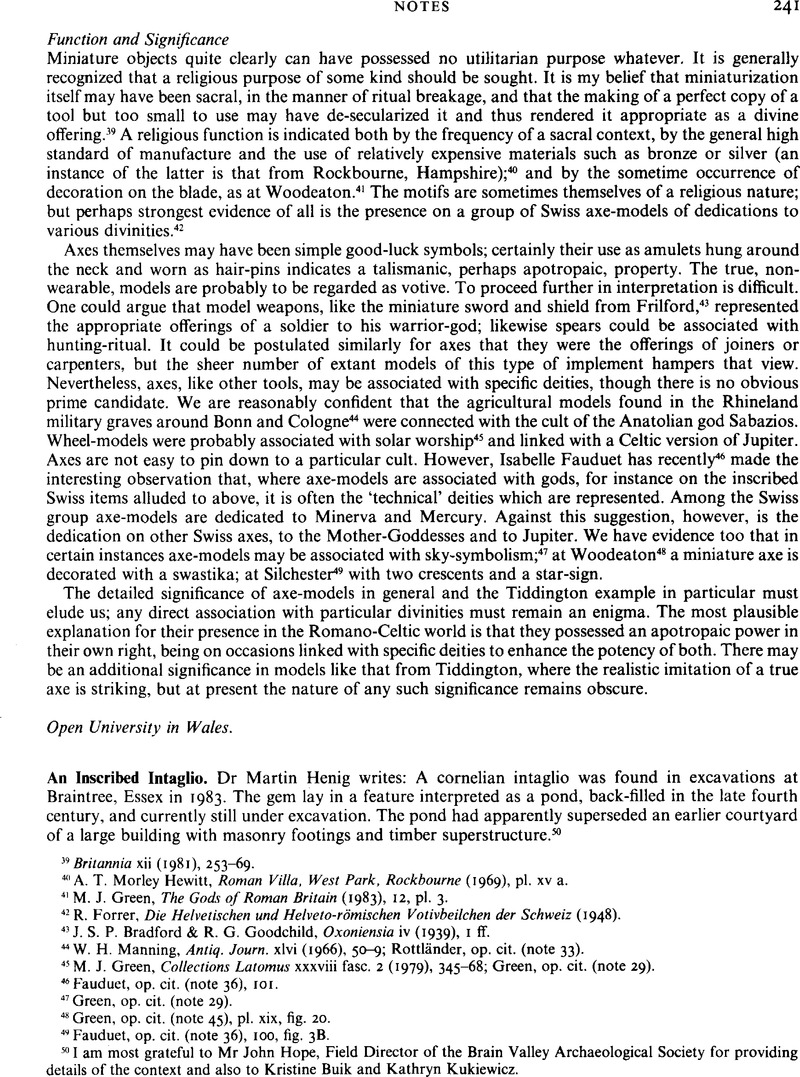No CrossRef data available.
Article contents
An Inscribed Intaglio
Published online by Cambridge University Press: 09 November 2011
Abstract

- Type
- Notes
- Information
- Copyright
- Copyright © Martin Henig 1985. Exclusive Licence to Publish: The Society for the Promotion of Roman Studies
References
50 I am most grateful to Mr John Hope, Field Director of the Brain Valley Archaeological Society for providing details of the context and also to Kristine Buik and Kathryn Kukiewicz.
51 Henig, M., A Corpus of Roman Engraved Gemstones from British Sites, BAR British Ser. 8, 2nd edition (1978), 35 fig. 1 Shape A5. The gem is c. 4 mm thick. In my description I describe the impression as is normal practice.Google Scholar
52 As Mark Hassall points out. See below p. 327.
53 Zwierlein-Diehl, E., Die Antiken Gemmen des Kunsthistorischen Museums in Wien I (Munich, 1973), 87–8Google Scholar no. 205. For comparanda note ibid. II (Munich, 1979), 153 no. 1200; inferior cutting and late in date but Asklepios to left. Also (A. to right), Furtwängler, A., Königliche Museen zu Berlin, Beschreibung der Geschnittenen Steine im Antiquarium (Berlin, 1896), 124 no. 2679Google Scholar; Richter, G. M. A., Metropolitan Museum of Art New York. Catalogue of the Engraved Gems. Greek, Etruscan and Roman (Rome, 1956), 79 no. 341Google Scholar; Maaskant-Kleibrink, M., Catalogue of the Engraved Gems in the Royal Coin Cabinet, The Hague. The Greek, Etruscan and Roman collections (The Hague, 1978), no. 664Google Scholar; Dimitrova-Milcheva, A., Antique Engraved Gems and Cameos in the National Archaeological Museum in Sofia (Sofia, 1981), 55 no. 109.Google Scholar
54 Henig, , op. cit. (note 51), 200 no. 285 (from the fort at Y Gaer, Brecon now located in the National Museum of Wales) and no. 286 (a gem set in a hellenistic bronze ring in the Grosvenor Museum, Chester. Perhaps from Chester).Google Scholar
55 Maaskant-Kleibrink, , op. cit. (note 53), 196–246.Google Scholar
56 Nutton, V., ‘A Greek Doctor at Chester,’ Journ. Chester Arch. Soc. lv (1968), 7–13Google Scholar; RIB 1028.Google Scholar
57 RIB 445; 609; 1072 (bilingual).Google Scholar
58 Henig, M., Religion in Roman Britain (London, 1984), 95–6. I have used the Greek names rather than the Latin Aesculapius and Salus partly because the legend on the gem seems to be Greek and partly because medicine, even in the West, was largely in Greek hands.Google Scholar




